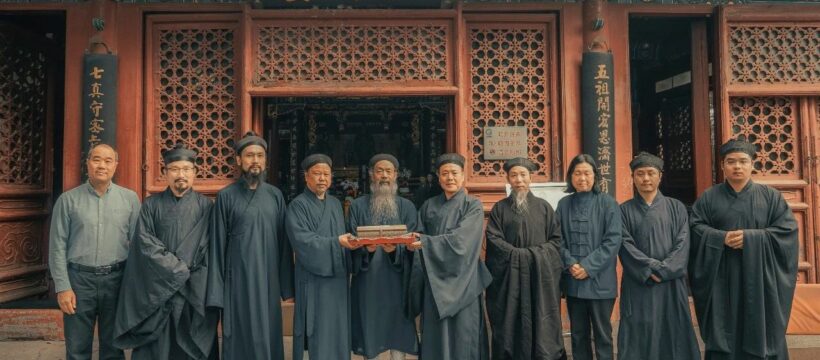Taoism, which originated in the late Eastern Han Dynasty, was founded by inheriting Taoist philosophy and underwent periods of growth and prosperity during the Sui and Tang Dynasties.
However, as time passed, it faced various challenges, and by the end of the Song Dynasty, it was in a state of decline. Patriarch Wang Chongyang, recognizing the prevailing issues, integrated the essence of Confucianism and Buddhism into Taoism, adopting the motto “The Unity of Three Religions, Understanding the Heart and Realizing the Nature, the Unification of All Truths.” He founded the Quanzhen sect, which gradually developed into one of the mainstream Taoist sects, alongside the Zhengyi sect.
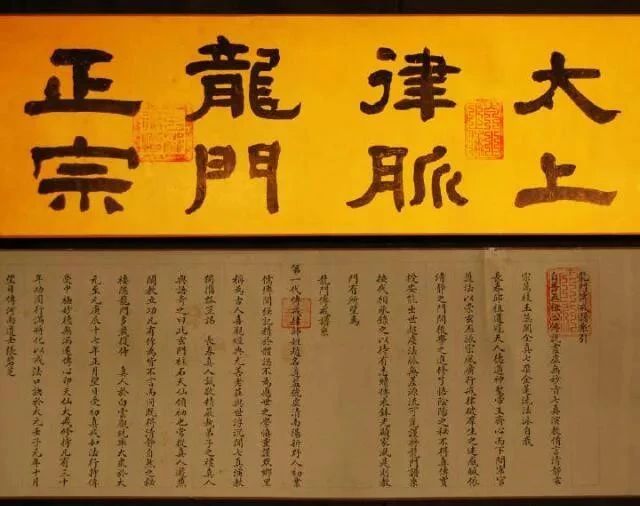
Wang Chongyang had many disciples, but Qiu Chuji made the most outstanding contributions and had a profound influence. Qiu Chuji, also known as Tongmi, was born in Qixia, Shandong. He yearned for the path of immortality from a young age. At the age of nineteen, he left home to study Taoism and lived at Kunyu Mountain. When he turned twenty, he went to the Quanzhen Temple in Ninghai, Shandong, and became a disciple of Wang Chongyang, receiving the Taoist name “Changchunzi.” After Wang Chongyang achieved immortality, Qiu Chuji guarded his tomb for three years. He then practiced rigorous self-cultivation for six years at Panxi in Shanxi and later went into seclusion in Longmen, Longzhou (now Longmen Cave in Longxian County, Baoji City, Shanxi) for seven years. During this time, he made significant spiritual progress, attained profound truths, and founded the Longmen sect, named after his place of seclusion.
The Longmen sect, with Qiu Chuji as its founding patriarch, emphasized the practice of self-mortification for the benefit of others. Its aim was to inherit the Quanzhen teaching and preserve the true essence of Laozi’s philosophy. The Longmen sect not only inherited traditional Taoist philosophy but also reorganized various Taoist cultural treasures such as rituals, precepts, and alchemy, making them the cornerstone of its profound doctrine, which solidified the foundation of Taoist thought for modern times.
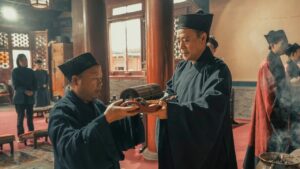
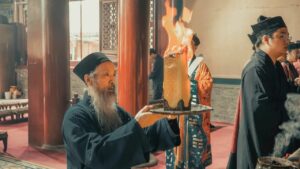
The saying “To govern the country, one must respect heaven and love the people; to cultivate oneself, one must clear the mind and reduce desires” was a spiritual guidance given by Qiu Chuji to Genghis Khan. In 1220, at the age of 73, Qiu Chuji traveled a long distance to meet Genghis Khan, a historic meeting known as the “Meeting of the Dragon and the Horse.” Qiu Chuji advised him to “respect heaven and love the people” and “clear the mind and reduce desires,” and Genghis Khan deeply appreciated his words. He honored Qiu Chuji as a divine being, entrusted him with the leadership of Taoism throughout the empire, and made the Taiji Palace in Beijing(now White Cloud Temple), where Qiu Chuji lived, the center of northern Taoism. This marked the peak of the Quanzhen Longmen sect, becoming one of the most prominent Taoist sects of the time. During the reign of Emperor Qianlong, Qiu Chuji’s advice to Genghis Khan to “stop killing” was highly appreciated, and he composed the following inscription: “Eternal longevity is not achieved by seeking the secrets of immortality in the rosy clouds; only when one ceases to kill, does one realize the extraordinary power to benefit the world.”
As Kublai Khan unified the south, Quanzhen Taoism quickly spread southward. This transmission had a profound impact on the development of Taoism, as the previously isolated northern and southern Taoist traditions gradually merged during exchanges. Wudang Mountain, situated at the border of the north and south, was among the first to be influenced by this transmission.
Ji Zhitong was the first Taoist of the Quanzhen sect to enter Wudang. He studied under Qiao Qiandao and was a disciple of Ma Yu and Qiu Chouji. According to the “Shanxi Tongzhi” (Shaanxi General Records), “Ji Zhitong resided in Wudang Mountain, not eating cooked food for ten years, but subsisting on yellow essence and astragalus, with a clear and pure spirit.” Ji Zhitong’s cultivation level was extremely high, and he had many disciples. The scale of the Longmen lineage of Wudang continued to expand.
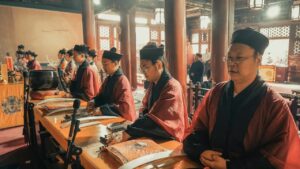
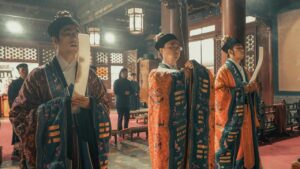
During the Ming Dynasty, Wudang Mountain received high praise and was bestowed with imperial favor. It became a royal temple and a significant center for the dissemination of Quanzhen Taoism. This is reflected in the mountain’s annals, local records, collections, and inscriptions. While upholding the spirit of pure cultivation, Quanzhen Taoism saw the emergence of a group of highly respected Taoists, with Qiu Xuanqing (a disciple of Zhang Sanfeng) as their representative. Additionally, figures like Sun Biyun and Li Suxi made significant contributions to the dissemination and teaching of Quanzhen Taoism. While Sun Biyun was not a Quanzhen Taoist, and Li Suxi did not belong to the Zhengyi sect, they broke through sectarian biases and, by drawing on the strengths of various traditions, promoted integration among different Taoist sects. During the Wanli era, Taoist Li Xuancheng of the Longmen lineage conducted practice at the Convergence of Immortals Temple (present-day Jinsha Ping) in pursuit of emptiness and clarity. Emperor Ming Shenzong ordered him to lead the temple’s Taoist community in presiding over the national Daoist rituals. All these events laid the foundation for the resurgence of the Longmen lineage during the Kangxi era under Wang Changyue.
Ancestral master Wang Changyue, born in the first year of the Jiajing era of the Ming Dynasty (1522), was a well-known Taoist and practitioner from Changzhi County, Shanxi. Originally named Wang Ping and also known as Kunyang, he felt a desire for spiritual detachment from a young age. He extensively visited famous mountains, seeking the Great Dao, studying classics from the three major traditions, and engaging in Daoist practice for many years. He had more than 20 teachers during his early years. In middle age, he became the disciple of Zhao Fuyang, the sixth-generation master of the Quanzhen Longmen lineage. Wang Changyue earnestly pursued the Dao and was imparted the methods of precepts and the Daoist heart by Zhao Fuyang. Later, Wang Changyue encountered his master again on Jiugong Mountain. His master asked him, ‘Lately, how have you been interacting with the world? What have you gained or lost?’ Wang Changyue expressed his sense of the decline of the Daoist spirit and his desire for his master’s guidance. In response, Zhao Fuyang taught him the ‘Great Precepts of the Heavenly Immortals.’ After parting ways with his master, Wang Changyue secluded himself on Qihua Mountain, Bai Dou Terrace. During the initial period of Emperor Shunzhi’s reign, Wang Changyue put up a solitary flag at Lingyou Temple. In the autumn of the twelfth year of Shunzhi (1655), he assumed the position of abbot at the Quanzhen ancestral temple, Baiyun Monastery. He was ordered to expound scriptures and transmit teachings. He went to the altar three times for explain the precepts, teached over a thousand disciples, and was awarded the purple robes three times. Because Emperor Kangxi had previously received the precepts of expedience from him, Quanzhen Taoism flourished greatly, and he was later acclaimed as the rejuvenator of the Quanzhen Longmen lineage.

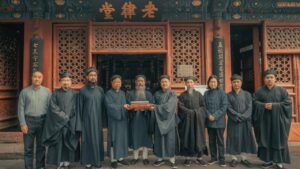
In the second year of Kangxi (1663), Wang Changyue led his disciples south to propagate the faith. ‘Wang Changyue led disciples like Zhan Shouchun and Shao Shoushan and others to establish altars and administer precepts in various places, such as Nanjing, Hangzhou, Huzhou, and Wudang Mountain. A multitude of southerners converted to Taoism.’ (Ren Jiyu: ‘History of Chinese Taoism’) During the initiation of precepts on Wudang Mountain, more than a thousand Yellow Caps congregated at Yuxu Palace, where banners fluttered and colored clouds billowed, with the aura of Dharma permeating the air. Many Wudang Mountain Taoists sought refuge under the guidance of Wang Changyue in the Longmen lineage. According to Wang Yun’s writings in the early Qing Dynasty, he and the Governor-General of Sichuan and Huguang, Cai Yurong, met Kunyang’s ancestral master at Fuzhen Monastery on Wudang Mountain in the twelfth year of Kangxi (1673). The ancestral master was known for his ‘skillful method of guiding and leading disciples, and had a multitude of followers.’ (Wang Yun: ‘Wandering Chronicles,’ Vol. 4, ‘Travels in Chu’) Longqiqian also recorded that Kunyang’s ancestral master ‘transmitted precepts in Yuxu Palace and then set his resolve to take refuge and uphold precepts…’ Many disciples received precepts through the transmission of Kunyang’s ancestral master, including prominent figures like Zhang Jingming, Zhang Zhenyuan, Qi Shoushan, Wang Changwen, Wang Changan, Zhan Tailin, Cai Taizhi, Yu Taiyuan, Xie Qingzhong, Chen Qingjue, and others. Through the teachings and precepts administered by various distinguished Longmen Taoists on Wudang Mountain, the Quanzhen Longmen lineage prospered during the Kangxi era.
Since the transmission of precepts by Master Kunyang at Wudang Mountain, it has been over 360 years. The Longmen lineage has thrived at Wudang Mountain, and its influence has spread to temples and monasteries of all sizes. The Yuanhe Monastery and Fuzhen Monastery consecutively established “tenfold forests” in the twentieth and twenty-ninth years of the Kangxi era to connect with Taoists from all around, and the teachings of Quanzhen Taoism became renowned nationwide. At the beginning of the Xianfeng era, temples like the Zixiao Palace, Nanyan Palace, Ying’en Palace, and other hermitages introduced the regulations of the Quanzhen Longmen lineage. In the sixth year of Xianfeng, the Red Turban Rebellion broke out, with Wudang as the primary battleground. Many temples suffered significant damage during the conflict, especially the Zixiao and Nanyan Palaces. The Qiongtai Central Monastery with 24 Daoist courtyards was reduced to rubble.
During the Tongzhi era, Daoist Yang Laiwang, the thirteenth-generation successor of the Longmen lineage, arrived at Wudang Mountain. He received numerous disciples and, after ten years of hard work, restored many temples, including the Zixiao and Nanyan Palaces, and transmitted the Longmen lineage’s regulations to various temples and hermitages. He became the rejuvenator of the Longmen lineage of Wudang Mountain during the late Qing Dynasty and early Republic of China.
In the late Qing Dynasty and early Republic of China, Xu Benshan, the fifteenth-generation disciple of the Quanzhen Longmen lineage and the Taoist head of Wudang Mountain, received the Three Altars Great Precepts at the Xuanmiao Monastery in Nanyang. In the twentieth year of the Guangxu era (1894), he returned to Wudang Mountain with a firm commitment to reorganize Taoism. He established religious rules, led the Taoist community in reclaiming and farming the land, collected donations from all directions, and used the funds to repair temples and mountain paths. This effort revitalized Taoism on Wudang Mountain. In April 1931, General He Long led the Red Army’s Third Front in a military campaign to Wudang Mountain. Xu Benshan and the Taoist community took great care of the wounded soldiers.
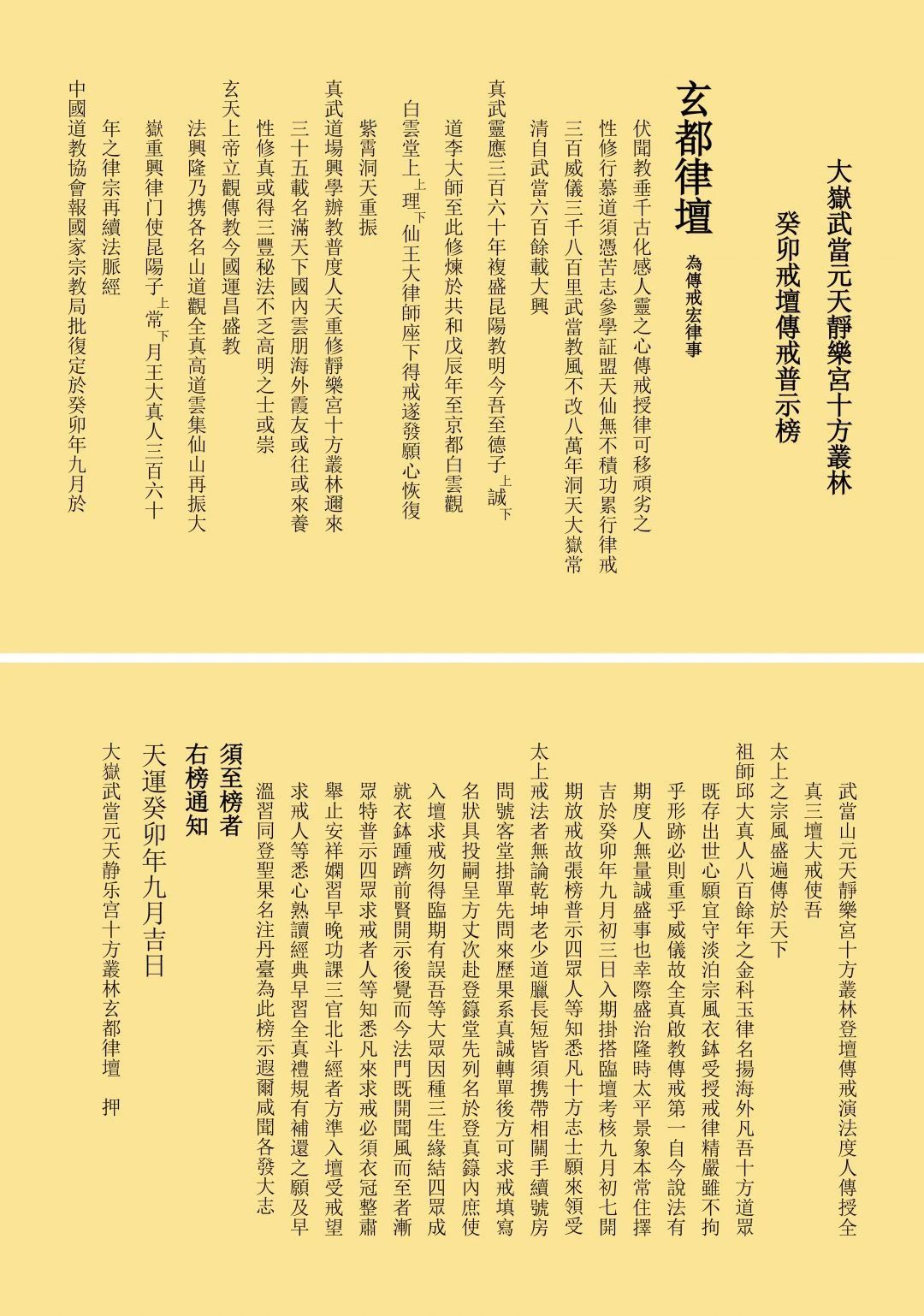
From its inception, Taoism has placed great emphasis on precepts and discipline, regarding them as the “code of the Dao.” Since its establishment, the Quanzhen Taoist tradition has considered observing precepts to be the foremost aspect of their spiritual practice. Quanzhen Taoists begin with the ritual of initiation and continue to observe and maintain precepts in their daily practices. This process involves self-restraint, self-reflection, and self-improvement. Quanzhen Taoists have a long history of following a strict code of conduct, which serves as the basis for their actions. For those on the path of spiritual cultivation, it is essential to accumulate virtue, establish a firm and pure mind, cultivate moral character, and refine the body. Without observing precepts, one cannot hope to attain true enlightenment. As Master Wang Changyue said, “The gate to immortality and Buddhism lies through precepts; the path of sages and worthies is walked by adhering to precepts. Indeed, it is the essential path for sages and worthies and the main gateway for immortality and Buddhism.”
Wudang Mountain has been blessed by the Dao, and its legacy has been carried forward. Today, Wudang Mountain is about to witness the ascension of the abbot and the transmission of precepts to Quanzhen Taoists. This is the inevitable result of generations of dedication, the flourishing of the Daoist spirit, and unwavering commitment to the sinicization of Daoism at Wudang Mountain.
(The author is the president of the Wudang Mountain Daoist Association.)
Written on the Abbot’s Promotion at Wudang Mountain’s Zixiao Palace and the Upcoming 2023 (Gui Mao) Quenzhen Sect Taoist Precepts Transmission Event
Written and Translated by Daoist Liu Cheng Yong, German Daoist Association.

